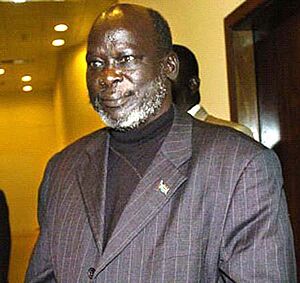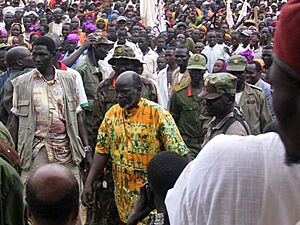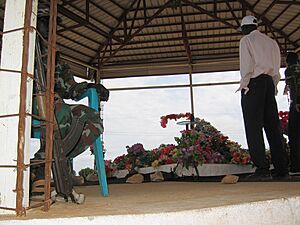John Garang facts for kids
Quick facts for kids
Dr.
John Garang
|
|
|---|---|
 |
|
| President of Southern Sudan (Autonomous Region) | |
| In office July 9, 2005 – July 30, 2005 |
|
| Vice President | Salva Kiir Mayardit |
| Preceded by | Position Created |
| Succeeded by | Salva Kiir Mayardit |
| First Vice President of Sudan | |
| In office January 9, 2005 – July 30, 2005 |
|
| President | Omar al-Bashir |
| Preceded by | Ali Osman Taha |
| Succeeded by | Salva Kiir Mayardit |
| Personal details | |
| Born |
John Garang de Mabior
June 23, 1945 Wangulei village, Twic East, Anglo-Egyptian Sudan (present-day South Sudan) |
| Died | July 30, 2005 (aged 60) New Cush, Republic of Sudan (present-day South Sudan) |
| Nationality | South Sudanese |
| Political party | Sudan People's Liberation Movement |
| Spouse | Rebecca Nyandeng De Mabior |
| Children | Mabior Garang De-Mabior Akuol de Mabior |
| Alma mater | Grinnell College (B.A.) Iowa State University (PhD) |
Dr. John Garang De Mabior (June 23, 1945 – July 30, 2005) was an important Sudanese politician and a leader who fought for change. From 1983 to 2005, he led the Sudan People's Liberation Army/Movement (SPLA/M). This group was a key player in the Second Sudanese Civil War. For a short time in 2005, he served as the First Vice President of Sudan. This was after a peace agreement was signed. He died in a helicopter crash on July 30, 2005.
John Garang was an expert in economics. He greatly influenced the movement that led to South Sudan becoming independent from the government of Omar al-Bashir, who was the president of Sudan (Khartoum).
Contents
Early Life and Education
John Garang is seen as one of the main founders of the Sudan People's Liberation Movement and Army. This group fought for a long time in Sudan. He was a member of the Dinka people, an ethnic group in Sudan.
He was born into a poor family in Wangulei village, in the Upper Nile region of Sudan. He became an orphan at age ten. A relative paid for his schooling, and he attended schools in Wau and then Rumbek.
In 1962, he joined the First Sudanese Civil War. However, because he was very young, leaders encouraged him and others his age to continue their education. Due to the fighting, Garang finished his high school studies in Tanzania.
He then won a scholarship. In 1969, he earned a Bachelor of Arts degree in Economics from Grinnell College in Iowa, United States. He was offered another scholarship for graduate studies. But he chose to return to Tanzania. There, he studied East African agricultural economics at the University of Dar es Salaam (UDSM).
Garang soon decided to go back to Sudan and join the rebels. The civil war ended with the Addis Ababa Agreement of 1972 in 1972. Garang, like many rebels, joined the Sudanese military.
For eleven years, he was a soldier. He rose from captain to colonel. He also took academic leave for four years. During this time, he earned a Master's degree in agricultural economics from Iowa State University (ISU). In 1981, he received his PhD in Economics from Iowa State University (ISU). By 1983, Colonel Garang was a senior instructor at a military academy near Omdurman.
His Vision for Sudan
Garang created an idea called "Sudanism." This was his guiding idea for a new, fair, and multi-ethnic New Sudan. He believed that for people in Sudan to live together peacefully, they should not focus on their many different ethnic groups. Instead, they should unite. He wanted citizens to embrace all cultures of Sudan. He hoped they would come together under one shared identity: being Sudanese.
Becoming a Rebel Leader
In 1983, Garang went to Bor. There, southern government soldiers were resisting being moved to posts in the north. He supported their fight. When Battalion 105 attacked the Sudanese army in Bor in May 1983, Garang joined the rebels in Ethiopia.
By the end of July, the Sudan People's Liberation Army/Movement (SPLA/M) had grown to over 3,000 soldiers. This group was against military rule and the government's Islamic laws. This event started the Second Sudanese Civil War. This conflict lasted twenty years and caused one and a half million deaths.
Even though Garang was Christian and most of southern Sudan was not Muslim, he did not first focus on the religious parts of the war. Garang strongly supported national unity. He believed that all minority groups together formed a majority and should rule. He thought they could replace President Omar al-Bashir with a government that included people from "all tribes and religions in Sudan."
The SPLA gained support from Libya, Uganda, and Ethiopia. Garang and his army controlled a large part of the southern regions. He called this area "New Sudan." He said his troops were brave because they believed they were fighting for a fair cause.
In 1991, the government in Ethiopia changed. This caused problems for the SPLA. Their training camps in Ethiopia were closed, and their weapons supply was cut off. This forced many Sudanese back to South Sudan.
Later, there were disagreements among SPLA leaders in August 1991. Some commanders, like Riek Machar and Lam Akol, formed a separate group called SPLA-Nasir. This caused fighting and made the communities in Southern Sudan more divided. The SPLA-Nasir accused Garang of ruling too strictly. But ethnic differences also played a part.
On September 14, 1992, William Bany, a high-ranking SPLA commander, left the SPLA. The next day, Commander Salva Kiir Mayardit was promoted to Bany's old positions. Bany joined forces with Machar and Akol to form SPLA-United.
Garang had refused to join earlier governments or elections. He remained a rebel leader. However, the SPLA and the government signed a peace agreement on January 9, 2005, in Nairobi, Kenya.
On July 9, 2005, he was sworn in as the First-Vice-President. This made him the second most powerful person in Sudan. At the same time, he became the leader in southern Sudan. This new government had some independence for six years. After that, there would be a vote on whether southern Sudan should become a separate country. No Christian or southerner had ever held such a high government job.
After the ceremony, Garang said, "I congratulate the Sudanese people, this is not my peace or the peace of al-Bashir, it is the peace of the Sudanese people."
Over 15 months, starting in September 2003, Ali Osman and Garang met privately in Naivasha. Their secret talks led to the Comprehensive Peace Agreement (CPA), signed on New Year's Eve 2004. The CPA seemed to match Garang's vision for a "New Sudan." Power was shared between the National Congress Party and the Sudan People's Liberation Movement for six years, with Garang as the first vice-president.
The United States State Department believed that Garang's role in the government would help solve the Darfur conflict in western Sudan. U.S. President George W. Bush supported South Sudanese independence. He saw Garang as a promising leader and called him a "partner in peace." Garang also used radio effectively to spread his message.
Death and Legacy
In late July 2005, John Garang died when the Ugandan presidential helicopter he was flying in crashed. He was returning from a meeting with President Yoweri Museveni of Uganda. He had not told the Sudanese government about this meeting. He had said he was going to spend the weekend in New Cush, a small village he founded.
After the helicopter was missing for over 24 hours, the Ugandan president told the Sudanese government. The SPLM first said the helicopter had landed safely. This was to gain time for new leadership arrangements within the SPLA. A few hours later, Sudan's Information Minister said the earlier report was wrong. Finally, the office of Sudanese President Omar el-Bashir confirmed the crash. It stated that the helicopter crashed into "a mountain range in southern Sudan because of poor visibility." This resulted in the death of Dr. John Garang DeMabior, six of his colleagues, and seven Ugandan crew members.
Many believe John Garang's work was a major reason for South Sudan's fight for independence. Without him, many people in Africa, including those in Sudan, might still be overlooked.
His body was taken to New Cush, a southern Sudanese settlement near the crash site. Former rebel fighters and supporters gathered to honor him. Garang's funeral took place on August 3 in Juba. His wife, Rebecca Nyandeng De Mabior, promised to continue his work. She said, In our culture we say "if you kill the lion, you see what the lioness will do".
Questions About His Death
Both the Sudanese government and the SPLA leader said bad weather caused the accident. However, some people had doubts about this, especially among the SPLA members. The Ugandan President, Yoweri Museveni, said that other "external factors" might have played a role.
There were also rumors and questions about leadership changes within the SPLM before the peace agreement was signed. Some thought these internal issues might be connected to Garang's death.
See also
 In Spanish: John Garang para niños
In Spanish: John Garang para niños
- First Sudanese Civil War
- Second Sudanese Civil War
- Sudan People's Liberation Army




